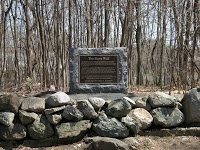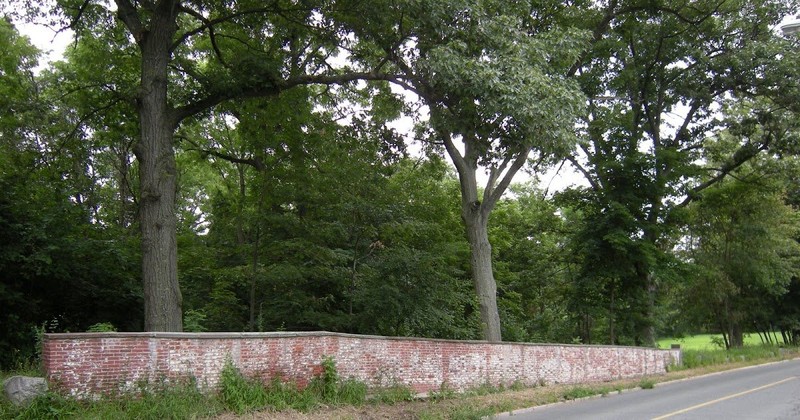Pomp's Wall / Slave Wall
Introduction
Text-to-speech Audio
Images
Slave Wall Marker (image from The British Redcoat)

Pomp's Wall (image from The British Redcoat)

Backstory and Context
Text-to-speech Audio
Though generally associated with the South, slavery was, in fact, legal throughout the colonies which became the United States until 1783, when Massachusetts became the first state to outlaw the institution. However, Massachusetts had also been the first colony to formally legalize slavery in 1641 and was one of the three New England states with the highest slave population, along with Connecticut and Rhode Island. There had been both African and Native American slaves in New England from its first Puritan settlements, as well as indentured servants from Scotland and Ireland. The first African slaves were brought from Tortugas to Medford eight years after its founding, in 1638, by Captain William Pierce. By the mid-1700s, there were 49 slaves in Medford out of a total population of 1,000; in the area, only Cambridge and Boston had a higher proportion of African American slaves. Slaveholder families in Medford (mainly ministers, doctors, and wealthy merchants) generally owned two slaves, many of whom were bought or descended from people bought through the Triangle Trade (1; 2; 3). Compared to Southern slaveholders, New Englanders held fewer slaves; this was due not to anti-slavery sentiment, but to the differences in geographic and economic differences between the North and South, including the more diversified economy of New England. Northern slaves worked in a wide range of skilled and unskilled labor jobs, domestic work, and agricultural work. Some of the jobs performed by African American slaves included: carpenters, shipwrights, bookbinders, bakers, printers, tailors, brickmakers, chimney sweeps, doctors, ferrymen, grocers, sailmakers, tanners, watchmakers, and many others (2). Unfortunately, New England slaves, like their Southern counterparts, could be whipped for transgressions as small as being off their master's property (3).
Isaac Royall owned more slaves than anyone else in Medford. Royall brought his 27 slaves with him from Antigua in 1737. Molasses from Antigua was brought to the colonies, where it was used to produce rum, one of Medford's main economic staples; this rum was then traded for slaves in Africa, who were then brought to the West Indies to work in the production of molasses or on to the Colonies to be sold. This series of exchanges was known as the Triangle Trade or Trans-Atlantic Slave Trade, from which Medford merchant Timothy Fitch, among others, made his living. African American poet Phillis Wheatley was brought to the colonies on one of Fitch's slave ships. There were some free African Americans in Medford, as well, who formed one of the oldest continuous African American communities in the United States. Most of these early freedmen and women had been enslaved for part of their lives, but had gained their freedom through contracts with their owners, or were emancipated for faithful service or through their owners' wills. Free Blacks in New England, legally and socially, occupied a position slightly above European indentured servants but certainly below white citizens (2).
Medford's Slave Wall was built in 1765 by a slave named Pomp, who belonged to Thomas Brooks. Pomp's wall served as a decorative element to the 400-acre Brooks Estate's semi-circular entrance drive, and along with the Royall House Slave Quarters, is one of only two physical reminders of Medford's history of slavery. Though only a portion of the brick wall and one granite post remain, the wall is a testament to Pomp's skill as a mason and a reminder that prominent Medford families such as the Brooks benefited from slavery and from the talents of the people they held as slaves (1; 2).
After Massachusetts outlawed slavery in 1783, one of the
former Royall slaves, Belinda, petitioned the Commonwealth for reparations.
Assisted by African American abolitionist and founder of Black Freemasonry
Prince Hall, Belinda eventually succeeded in obtaining back pension from the
Royalls. Prince Hall, a freedman born in Barbados in 1748, lived in Boston and
then Medford, where he joined the Continental Army and fought at the Battle of
Bunker Hill. He became an African Methodist Episcopal minister, preaching in
Cambridge, and petitioned for emancipation as early as 1777. In founding the
African Masonic Lodge, Hall also established the first Black institution in the
United States (2). One of Medford's leading white abolitionists was George
Luther Stearns, a linseed oil merchant and supporter of John Brown, who raided
Harper's-Ferry, Virginia in 1859 in an attempt to free a number of slaves. Stearns'
Tudor-style mansion near present-day Tufts University's Cousens Gym was a stop
on the Underground Railroad, until Stearns was forced to flee to Canada after
Brown's arrest. During the Civil War, Medford's Lawrence Light Guard served at
Bull Run, as part of the Provost Guard in Washington, and as part of the Army
of the Potomac. Over the course of the war, 769 Medford men served in the Union
Army, and a number of Medford women contributed to the Sanitary Commission, the
relief agency for soldiers (3).
